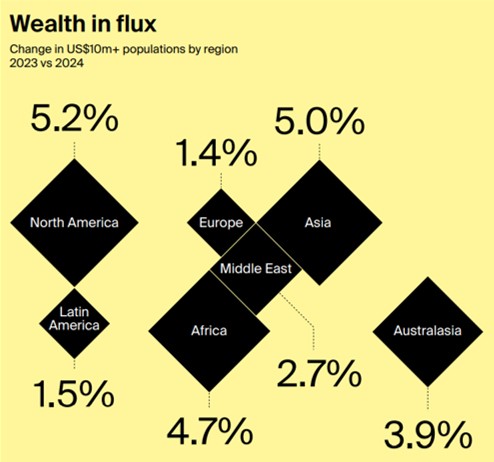WM Market Reports
Family Offices Love Real Estate, US Leads Wealth Growth – Knight Frank Study

The property market consultancy and realtor casts its eye over trends shaping certain segments of the world's brick-and-mortar market.
Real estate investment remains a major focus for family offices,
with 44 per cent global family offices questioned in a new report
saying they intend to hike allocations.
The findings are from the 19th edition of an annual wealth report
by international real estate consultancy Knight Frank.
“Despite a sharp fall in investment volumes from the 2021 peak,
we confirm an ongoing desire for property from private capital,”
the report said. “While direct real estate ownership already
accounts for 22.5 per cent of the typical family office’s
portfolio, more than four in 10 are looking to grow this
allocation over the next 18 months.”
“Sectors in demand are led by living, logistics and luxury
residential. In addition to this desired expansion of investment
portfolios, nearly a quarter of family offices that manage
private residential portfolios are considering new acquisitions,”
it continued.
Through November and December 2024, Knight Frank said it
interviewed 150 single and multi-family offices across the globe.
This covered 121 single-family and 18 multi-family offices
as well as 11 heads of more diverse structures. The FOs
were headquartered in 29 cities across Asia, Europe, the
Middle East and the Americas, with "strong
representation" from FOs based in London,
Singapore, New York, Geneva, Sydney and Hong Kong.
The firm looked into the reasons why family offices own real
estate and how much borrowing they are exposed to in this asset
class.
"Across the different metrics employed, FOs on average
target an unleveraged 13.8 per cent return. In terms of
the objectives that real estate fulfils in the wider
investment portfolio growth and capital
appreciation (42 per cent) dominates, with
wealth preservation (23 per cent) and income
generation (19 per cent) in second and third places," it
said.
The indispensable nation
The 88-page report finds that the US “remains the undisputed
leader in global wealth creation.” Almost 40 per cent of the
world’s wealthy reside in the US. “No other country is as
successful at creating homegrown wealth or attracting migrant
UHNWIs,” it said. “For luxury homes, private jets and
superyachts, what happens in the US shapes global markets.”
The report defines “high net worth” as a person having $1 million
more in wealth; “ultra-HNW” is $30 million-plus. Its “Wealth
Sizing Model” defines HNW individuals as those with a net worth
of at least $10 million; the UHNW version of this model pegs the
figure as at least $100 million.
The reports sets out changes in the wealth held in different
regions.
"In 2024, the fortunes of the wealthy improved, with a 4.4
per cent hike in the number of individuals worth over
$10 million. All regions saw an uptick, but North America
led with growth of 5.2 per cent. Future wealth creation,
especially in the ultra-wealthy ($100 million+) segment, is
likely to be subject to a more activist regulatory
and tax response," it said.

Source: Knight Frank
The report says that wealth mobility is “only set to
increase,” saying that this theme is driving “supercharged
growth” in some housing markets, with Miami, Palm Beach and Aspen
in the US serving as prime examples. “The ease with which wealth
can move is driving efforts to attract it and attempts to control
it. While private jets and yachts should promote mobility, we
delve into some surprising limitations,” it said.
The luxury property market is also being shaped by moves in
market pricing and currencies, Knight Frank said. Its review of
changes to buying power showed that while London offers savings
of 43 per cent for dollar-based buyers compared with pricing in
2014, other markets have seen equally dramatic falls in relative
buying power, with some weakening by more than 50 per
cent over the period.
On the well-trodden theme of intergenerational wealth transfer,
Knight Frank said this process is well underway, even though Baby
Boomers still control most global wealth.
The report contains a warning about more difficult economic times
possibly ahead – the report came out days after the US slapped
tariffs on neighbours Canada and Mexico, as well as
China.
“The world economy has had a good run. Global GDP surpassed its
pre-pandemic peak in mid-2021 and has continued to expand at
around 3 per cent every year since. Will 2025 be the year that
run ends? It’s possible, perhaps even likely. The US has a new,
volatile president, a man inviting trade wars on multiple fronts.
Inflation isn’t quite tamed. Government deficits appear out of
control. Stock market valuations are inflated. War is ongoing in
various theatres, and could spread to others,” it said.
